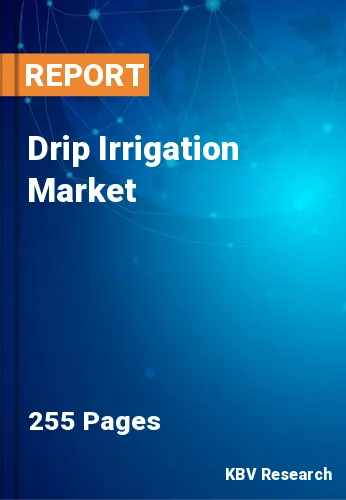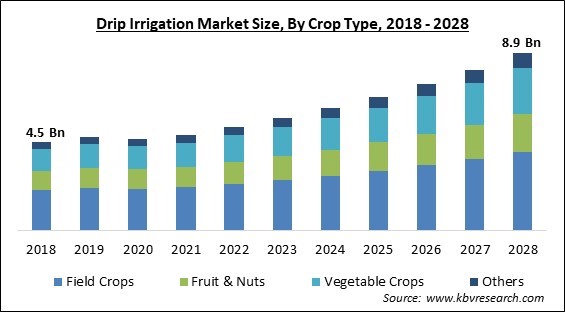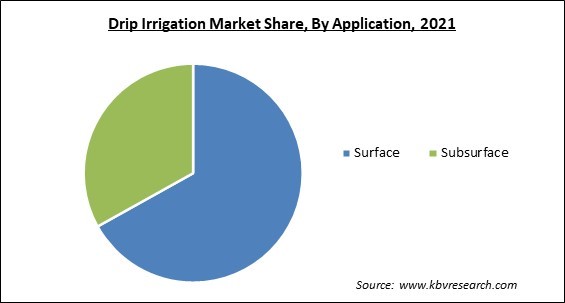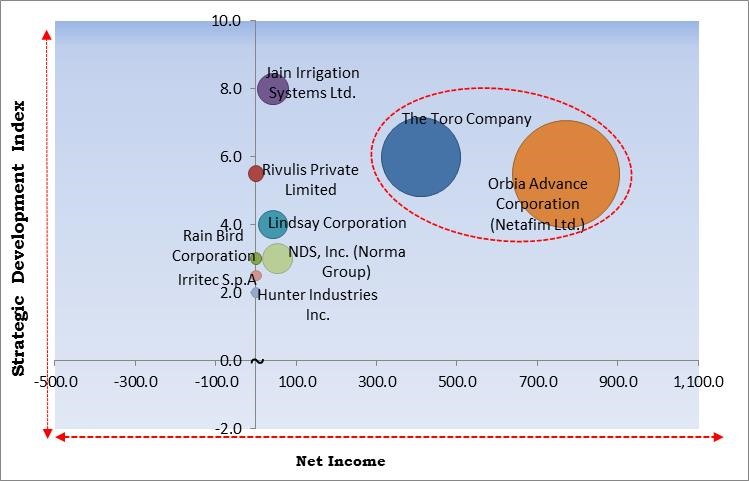
The Global Drip Irrigation Market size is expected to reach $8.9 billion by 2028, rising at a market growth of 9.4% CAGR during the forecast period.
Drip Irrigation, also identified as trickle irrigation, is a sort of micro-irrigation that ensures the gradual distribution of water to the soil surface constantly over a longer period of time by means of small diameter tubes and pipes that deliver water drop by drop to the root zone of the plants via drippers. Drip Irrigation is one of the most efficient methods of irrigation due to the fact that water is provided straight to the plant's root.

Drip Irrigation is applied for nearly all forms of horticultural plants and vegetables. The primary purpose of drip irrigation technology is to control wastewater. In sandy soils, Drip Irrigation prevents water loss caused by deep percolation, evaporation, and runoff. The drip water system can also be called the stream water system and is an exceptional method for giving water directly to the plant's root systems, in contrast to the sprinkler water system, which wets the entire soil profile.
These aids significantly conserve water. The trickling water system supplies water at a slow rate for the most part. Its speed ranges between approximately 2 and 20 liters per hour. This addresses the productive use of water and prevents the collection of excess water. Farms, business greenhouses, and household gardens employ drip irrigation.
In regions with severe water scarcity, drip irrigation is widely used, particularly for coconuts, container-based landscape bananas, ber, trees, grapes, eggplant, citrus, sugarcane, cotton, strawberries, maize, and tomatoes. Increasingly popular among homeowners, drip irrigation kits for home gardens comprise a timer, hose, and emitter. To water flower pots, 4 mm (0.16 in)-diameter hoses are utilized.
The COVID-19 pandemic caused major damage to various economies all over the world. Numerous businesses all over the world were significantly demolished due to the abrupt emergence of the outbreak. Moreover, the COVID-19 pandemic also had a major impact on the drip irrigation market. Agricultural activities were also restricted under the lockdown imposed by governments all over the world, which limited the demand for tools and technologies in the agriculture sector throughout the world. Furthermore, the pandemic continues to have complex and far-reaching impacts on the water-energy-biological food system nexus.
Agriculture's labor force requirements have decreased as a result of technological advancements. Depending on the extent of automation, the work required to run a drip irrigation system is deemed minimal. In addition to crop fields, this sort of irrigation has been utilized in landscapes, home gardens, greenhouses, field crops, orchards, and vineyards. The application of fertilizer using drip irrigation, commonly known as fertigation, is possible. Through fertigation, nutrients and water are delivered close to the root zone, resulting in increased crop absorption.
Drip irrigation systems are suitable for fields and landscapes with irregular contours, topography, or soil texture. Because drip systems are essentially more flexible, growers and landscapers can readily adjust a system as needed. This frequently results in increased system efficiency. Typically, less nitrogen is required when drip irrigation is utilized. As a result of the drip system's method of watering plants, less fertilizer goes beyond the root zone. Injecting fertilizers into the drip irrigation system provides plants with constant nourishment.
One of the major factors that are restricting the growth of the drip irrigation market is the high cost of acquisition along with significant maintenance expenses of a drip irrigation system. A drip irrigation system necessitates continuous pressure to maintain a consistent water flow. Continuous water flow through lateral pipes may result in the growth of algae, resulting in the clogging of emitters. Additionally, drip irrigation system replacement is expensive. In addition, these systems are difficult to maintain because they require weekly chlorination, which would increase the expense.

Based on Application, the Drip Irrigation Market is divided into Surface application and Subsurface application. In 2021, the surface drip segment witnessed the largest revenue share of the drip irrigation market. The growing demand for surface drip irrigation systems is caused by their low installation and maintenance costs. Widespread usage of surface drip irrigation equipment for perennials, like vines and trees, and annual row crops. However, the design and operation of irrigation equipment for these crops differ from that of conventional row crops.
Based on Crop Type, the Drip Irrigation Market is segmented into Field crops, Fruit & nuts, Vegetable crops, and other crops. In 2021, the fruit & nut segment garnered a significant revenue share of the drip irrigation market. The demand has increased due to expanding exports and a healthy profit margin, as well as the technique's increased application. The technology benefits fruit trees such as grapes, bananas, citrus, pomegranate, papaya, sweet lime, mango, and watermelon. They increase fruit production, hasten maturation, and conserve water. Therefore, these factors are augmenting the growth of this segment of the market.
On the basis of Component, the Drip Irrigation Market is segregated into Drip mainlines/drip tubes, Filters & fertilizer injectors, Fittings & accessories, Emitters/drippers, Pressure pumps, and Valves. In 2021, the pressure pumps segment registered a promising revenue share of the drip irrigation market. The emitters of pressure pumps are designed to release water at a very consistent rate over a wide variety of water pressures as they would provide the same flow under varied input pressure and terrain circumstances. PC emitters are most effective on plots with declines in height, which result in an increase in atmospheric pressure.
By Emitter/dripper type, the Drip Irrigation Market is bifurcated into Inline emitters and Online emitters. In 2021, the inline emitters segment witnessed the largest revenue share of the drip irrigation market. During the manufacturing process of inline drip tubing, drip emitters are inserted directly into the tubing at evenly spaced intervals. For each emitter, typically two holes are punched into the tubing at a particular spot, through which the water will drip. The growth of the segment is increasing at a very rapid pace as a result of the ease of deployment of this type of emitter.
| Report Attribute | Details |
|---|---|
| Market size value in 2021 | USD 4.8 Billion |
| Market size forecast in 2028 | USD 8.9 Billion |
| Base Year | 2021 |
| Historical Period | 2018 to 2020 |
| Forecast Period | 2022 to 2028 |
| Revenue Growth Rate | CAGR of 9.4% from 2022 to 2028 |
| Number of Pages | 255 |
| Number of Tables | 464 |
| Report coverage | Market Trends, Revenue Estimation and Forecast, Segmentation Analysis, Regional and Country Breakdown, Competitive Landscape, Companies Strategic Developments, Company Profiling |
| Segments covered | Crop Type, Application, Component, Region |
| Country scope | US, Canada, Mexico, Germany, UK, France, Russia, Spain, Italy, China, Japan, India, South Korea, Singapore, Malaysia, Brazil, Argentina, UAE, Saudi Arabia, South Africa, Nigeria |
| Growth Drivers |
|
| Restraints |
|
Region-Wise, the Drip Irrigation Market is analyzed across North America, Europe, Asia-Pacific, and LAMEA. In 2021, Asia-Pacific accounted for the largest revenue share of the drip irrigation market. the rapid rise in the growth of the segment is majorly attributed to the rapidly expanding agriculture sector of the region. Agriculture is a primary occupation of a significant proportion of the regional population, due to which, there is a significant number of advancements within the regional agricultural technologies and methods. This factor is bolstering the adoption of drip irrigation technology in the region and the growth of the regional market is estimated to increase as a result of this.
Free Valuable Insights: Global Drip Irrigation Market to reach USD 8.9 Billion by 2028

The major strategies followed by the market participants are Product Launches. Based on the Analysis presented in the Cardinal matrix; Orbia Advance Corporation (Netafim Ltd.) and The Toro Company are the forerunners in the Drip Irrigation Market. Companies such as Jain Irrigation Systems Ltd., Rivulis Private Limited (Temasek Holdings), Lindsay Corporation are some of the key innovators in Drip Irrigation Market.
The market research report covers the analysis of key stake holders of the market. Key companies profiled in the report include Orbia Advance Corporation (Netafim Ltd.), The Toro Company, NDS, Inc. (Norma Group), Jain Irrigation Systems Limited, Lindsay Corporation, Irritec S.p.A, Rivulis Private Limited (Temasek Holdings), Hunter Industries, Inc., Rain Bird Corporation and DripWorks, Inc.
By Application
By Crop Type
By Component
By Geography
The global Drip Irrigation Market size is expected to reach $8.9 billion by 2028.
Enables higher cost efficiency within agricultural operations are driving the market in coming years, however, High initial and maintenance costs along with complex deployment process restraints the growth of the market.
Orbia Advance Corporation (Netafim Ltd.), The Toro Company, NDS, Inc. (Norma Group), Jain Irrigation Systems Limited, Lindsay Corporation, Irritec S.p.A, Rivulis Private Limited (Temasek Holdings), Hunter Industries, Inc., Rain Bird Corporation and DripWorks, Inc.
The expected CAGR of the Drip Irrigation Market is 9.4% from 2022 to 2028.
The Field Crops market acquired maximum revenue share in the Global Drip Irrigation Market by Crop Type in 2021; thereby, achieving a market value of $3.9 billion by 2028.
The Asia Pacific market dominated the Global Drip Irrigation Market by Region in 2021; thereby, achieving a market value of $3.3 billion by 2028.
Our team of dedicated experts can provide you with attractive expansion opportunities for your business.
